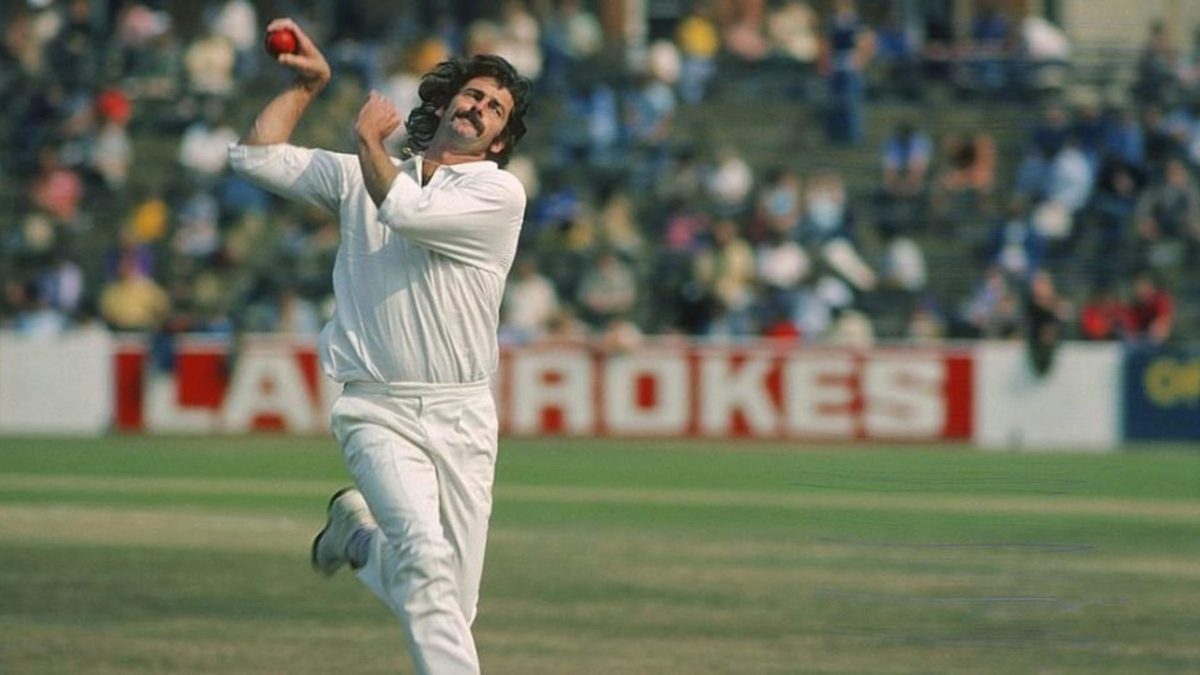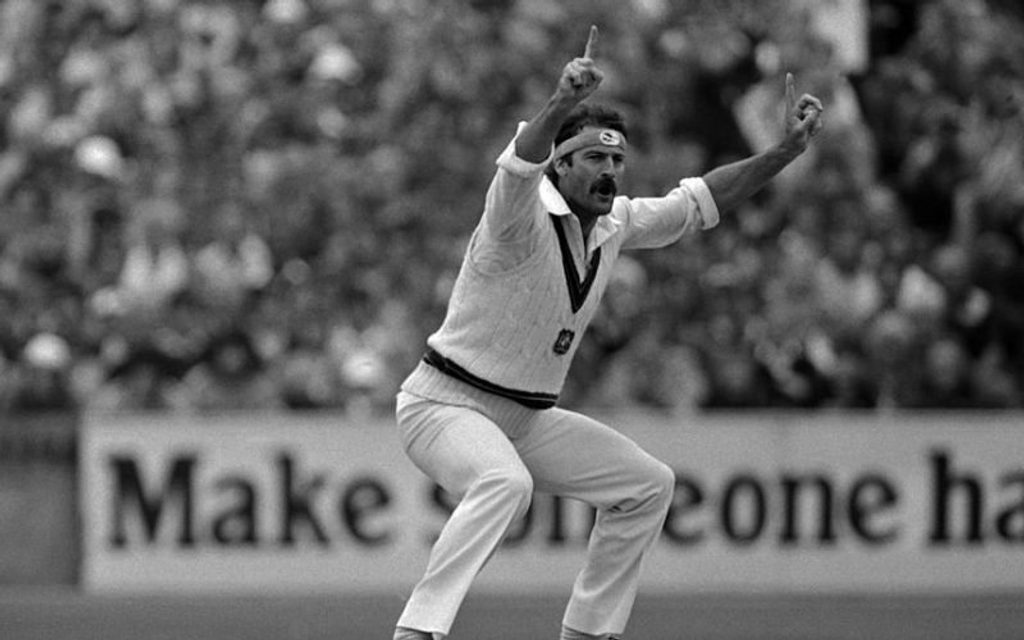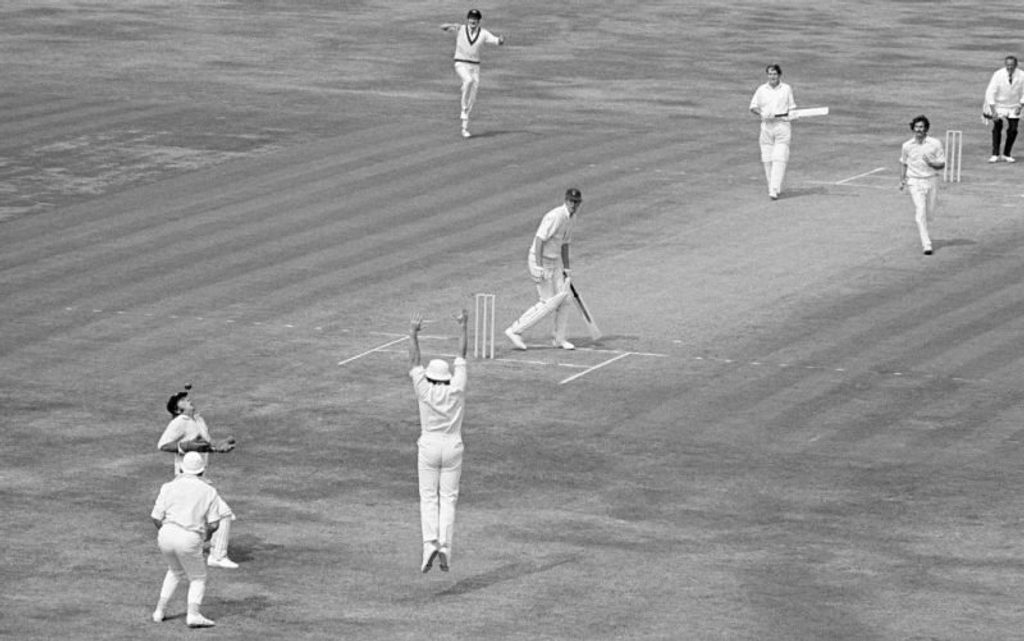
Dennis Lillee announced himself to English audiences with an outstanding performance in the 1972 Ashes series. It earned him a Wisden Cricketer of the Year award.
Despite a serious back injury and a spell in World Series Cricket, Dennis Lillee went on to be one of the great fast bowlers of all time. In 70 Tests, he took 355 wickets at 23.92.
The Haslingden club in the Lancashire League has a lot to answer for in the emergence of Dennis Lillee as Australia’s trump card in the 1972 tour of England. Lillee, who is not yet at his peak, should be in even better bowling form when the England side comes to Australia next year, and he gives full credit to the season he had in Lancashire League cricket.
“I think it was probably one of the real turning points in my career. It certainly forced me to become more accurate and learn a little bit about bowling, rather than merely thump down the ball as fast as possible. Quite often in the League games, footholds would be too slippery to bowl really fast, and accuracy and movement off the pitch would be the prime requirements. Now this couldn’t have come at a better time as, up to that stage, I’d been concentrating solely on pace.”
Not too many English spectators will hold it against the Lancashire League club that they had a hand in the emergence of Lillee as a fine fast bowler on that tour. He definitely added excitement to the game of cricket, if one can excuse the problem of perhaps too long a run to the crease. But, in keeping with other great fast bowlers like Lindwall, Tyson and Hall, the long run is inclined to add to the excitement. The dull thing is to watch a medium pacer take too long a run – to see some of the players named above, scorching their way into the bowling crease, is a matter of apprehension for the batsman and excitement for the spectator.
***
Dennis Keith Lillee was born at Subiaco, Perth, on July 18, 1949, and, after attending Belmay Primary School and Belmont Secondary School, he began playing with the Perth Cricket Club when 15 years of age. Four years later, he made his debut against Queensland at Brisbane, capturing the wicket of the Australian Test opening batsman, Sam Trimble, as his first victim in first-class cricket. It was a moderate debut by the then slimly built West Australian, for he took two for 60 in the first innings and one for 16 in the second. But, from that point on, he could do nothing wrong.
Australia had been looking for a fast bowler ever since the retirement of that great left-hander, Alan Davidson, and, although McKenzie had shouldered much of the burden from that time, there was a tremendous need for someone with extra pace to come into the national side. At that stage Lillee was very raw, but he could have been the answer – a thought with which the selectors obviously concurred for they sent him to New Zealand with an Australian B side at the conclusion of that 1969/70 season in which he had taken 32 wickets.
 Dennis Lillee was the first-ever bowler to 350 Test wickets
Dennis Lillee was the first-ever bowler to 350 Test wickets
In the team, captained by Sam Trimble, were other Test players – Alan Thomson, Dave Renneberg and Graeme Watson, but only Lillee was fast enough to counter the slow pitches on which many of the games were played. In all the first-class matches he topped the averages, with 16 wickets at 18.00, and generally he made a good impression.
This was the fast and furious Lillee, who paid scant regard in those days to accuracy and the finer points of bowling, but concentrated only on getting the ball from his end to the batsman’s end in the shortest possible time. The following season in Australia he had the unnerving experience of bowling when Barry Richards hit that astonishing 356 off the Western Australian attack at Perth. Lillee’s share was 18 overs, no wicket for 117, and he still marvels at the stroke-play of Richards on that day.
https://www.youtube.com/watch?v=ZdyWYT950jU
That season, 1970/71, was the Australian year of fast bowlers – for England anyway. Snow, Willis and Lever gave the Australians a torrid time and, with the third Test match at Sydney going to England by a mammoth 299 runs and the fifth in Melbourne being drawn, the Australian selectors decided to make changes for the sixth Test at Adelaide. To do this, they put in Lillee and he repaid them by taking five wickets in the first innings and going on to take another three wickets in the final Test match played at Sydney, a game also won by England.
To that stage, the Australian representation had been the high point of the career of a man who acknowledges the assistance received from coaches and others on the way up to Test stardom. “I’ve been lucky, in that people have always been keen to help me,” he says. “Mick Basile, who coached me with the Under-16’s and the Metropolitan Seniors, and Bert Rigg who is an ex-State player in Perth, together with Hugh Bevan, the West Australian opening bowler, have been very good to me in this regard, as was Ray Lindwall when I was trying to get my run-up and action sorted out a couple of years ago.”
The Perth pitch, prepared by Roy Abbott, has traditionally assisted pace bowlers since Western Australia came into the Australian Sheffield Shield competition. Harry Price and Harry Gorringe, Ron Gaunt and Des Hoare, with the medium-pacer Ray Strauss, now Lillee and Massie, have all turned in some great performances on this fast strip. Lillee found these Perth conditions very much to his liking when he burst on the first-class scene, even with his long run and slightly sprawling run-up and action.
When the South African tour of Australia was cancelled in 1971, a series against the Rest of the World XI was put on in its place and Lillee, in the opening game at Brisbane, gave the first indication of the big advance his bowling had made in the off season. Although his figures were one for 73 and two for 38, his more compact run to the crease and much better control impressed sound judges at the Gabba over the five days of that game. He was more confident in his approach to the opposing batsmen and, when the second representative game came along in Perth on December 10, 1971, Australians, for the first time since Davidson, were able to welcome a new fast bowling star.
https://www.youtube.com/watch?v=wW83dL0D334
The match was scheduled for five days but lasted only three. The World XI side made just 59 in their first innings, Lillee taking eight for 29, and then he chipped in with four for 63 in the second innings, allowing Australia to win by an innings and 11 runs.
Lillee marks this down as his most memorable game of cricket. “I felt shocking when I got to the ground – some sort of virus was going around Perth at the time – and, after bowling a couple of overs for the wickets of Gavaskar and Engineer, I felt terribly tired and asked Ian Chappell if I could possibly have a rest. He talked me into having one more over and things suddenly began to happen after McKenzie dismissed Kanhai and Zaheer was run out.
“I think that was the most memorable match I’ve played in from a personal performance point of view, but the best bowling experience I’ve had was in the final Test at The Oval, where we just had to win that match to square the series. It was a really hard grind on a beautiful batting pitch that gave a little bit of assistance to the pace bowlers if they were prepared to put a bit into it, and I finished up bowling 56 overs in the game. It would have been nice to put my feet up after that without any worries but we still had to make nearly 250 to win the game and square the rubber and it was one of the most nerve-racking innings I’ve watched.”
 Lillee has Tony Greig caught behind by Rod Marsh in The Oval Test of 1972
Lillee has Tony Greig caught behind by Rod Marsh in The Oval Test of 1972
All this success came about after an equally tense period at the start of the tour when Lillee was troubled by a back and hip injury and, at one stage, he gave himself little chance of playing in any of the Tests. “I think the best moment I had on tour was when I managed to get through a day of bowling and had absolutely no problem from my back injury – I suppose it might have been partly psychological but, from that time, everything went right and I had no injury troubles for the rest of the time we were in England.
“It really was a marvellous tour for us and it’s a great feeling to know you’ve been part of something that has perhaps made cricket more popular or helped the game as far as the public is concerned, and it was wonderful to see the big crowds at every Test match over there. I’m not sure though that I agree a drawn series was a fair result. I feel we were the better side and, given a good cricket pitch, instead of the one we had at Headingley, I think we’d be holding the Ashes now.”
There is little doubt that Lillee’s time with Haslingden gave him something of an insight into English conditions, as was the case with Massie, Greg Chappell and Stackpole, all of whom, in varying circumstances, had experience of English pitches. Lillee found the same thing, as had Ray Lindwall, when he came across to England on his first tour – that it is necessary to keep the ball more up to the batsman and that, if the fast bowler does this, he gets quite a bit more assistance both in the air and off the pitch.
In the Test series, Lillee did a magnificent job for his skipper, Ian Chappell, bowling 250 overs and breaking the Australian wicket-taking record for a series against England with 31 victims. His long hair flying and his features adorned with a moustache in the best tradition of old-time cricketers, such as Spofforth, he always posed a problem, even for the best of England’s batsmen. Most of these problems were posed for the earlier batsmen, of whom Luckhurst made 168 runs at 24, Edrich 218 runs at 21 and Boycott 72 runs at 18.
With Massie at the other end, he was the speed partner in a combination in the very best traditions of fast bowling pairs over the years. Though he looks flamboyant in action on the field, Lillee is essentially a man of simple character, preferring a king-size steak to the more spicy continental dishes, and the occasional glass of beer to a magnum of champagne.
He began the 1972/73 Australian season just where he had left off the England tour and, by the time Western Australia had played their matches up to the start of the First Test against Pakistan, he had taken 40 wickets to be well ahead of any other bowler in Australia. On the field, a man who shows an obvious dislike to batsmen, he is of equable temperament once the day’s play is over, and the only thing he is prepared to dislike in cricket at the moment is the type of field set for him in one-day cricket fixtures on the England tour. “There was one occasion where they even wanted to take my slip away,” he said. “When that happens, it’s almost time to give the game away.”
The least comforting thing for England’s batsmen is that Lillee should be right at his peak when England arrive in Australia on the next occasion and he should still be in good bowling form in 1977 when at the age of 28, he accompanies the next Australian team to England.
Happy birthday to DK Lillee, one of the great quicks. pic.twitter.com/DBE00Bwwc6
— Wisden (@WisdenCricket) July 18, 2020







